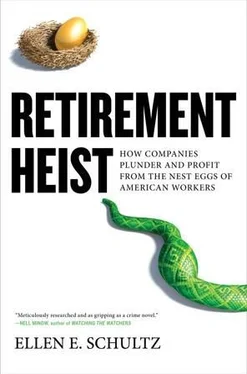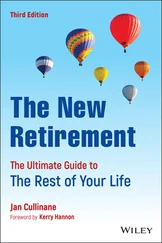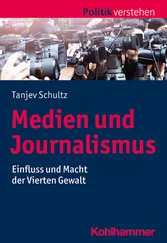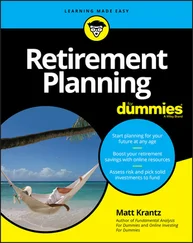The spin job didn’t stop. In a financial filing discussing its pending merger with French telecom giant Alcatel SA in 2005, Lucent referred to its “costly” retiree plans and said that the combined company might have to take steps to reduce those costs.
It didn’t mention that the pension plan, which by then covered 230,000 retirees and employees, was again so flush that it pumped $973 million of noncash income into Lucent’s earnings in fiscal 2005—about 82 percent of the company’s pretax profit for the year. The only U.S. pension creating a drag on earnings was the supplemental pension for its 2,500 executives—its liability had grown to $422 million.
In 2005, Russo was awarded $3.6 million on top of her base salary of $1.2 million, and was granted an additional $8.7 million in restricted stock and options, a total of $13.5 million in 2005, a year the company would have been unprofitable were it not for the gains from its pension.
Lucent continued to benefit from the retiree plans. It used another $2 billion in pension assets to pay for retiree health care, and when it merged with Alcatel in 2006 to become Alcatel-Lucent, it still had a dowry of $5 billion in surplus pension assets.
The new French owners of the portfolio of American retirees continued to benefit from their investment: Alcatel-Lucent continued to pick away at the benefits. Thanks to gains from benefits cuts, plus pension income, the pension plan generated $1.7 billion in income in 2007, without which the company would have reported a loss of $1 billion. Alcatel-Lucent executives achieved their performance targets and were awarded their bonuses.
In 2008, Lucent eliminated its prescription drug plan for salaried retirees altogether, which generated $358 million in income. Russo stepped down at the end of the year, taking with her $8 million in severance.
In October 2009, the company froze the pensions of its 11,500 management employees. Their loss was Alcatel-Lucent’s gain: a $531 million boost to profits.
Chapter 6
WEALTH TRANSFER
The Hidden Burden of Spiraling Executive Pensions and Pay
WHEN HENRY SCHACHTwas delivering the bad news to Lucent retirees, there was one retiree in the room who wasn’t going to feel the pain. That was Schacht himself. As a former CEO, Schacht had accrued a small fortune, joining the club of executives with enough retirement wealth not only to retire to an island but to buy it.
While Lucent and other companies were cutting benefits for hundreds of thousands of retirees to the bone, they were lavishing increasingly enormous sums on top management. This isn’t simply an issue of disparity; it’s a transfer of wealth. Billions of dollars earmarked to pay pensions and health care benefits to retirees were consumed, one way or another, by management teams who profited from the short-term income lift these maneuvers generated.
The dismantling of retiree plans did something more than boost profits. It helped fuel the growth of a parallel universe of executive pensions and benefits. Largely hidden, these growing executive retirement liabilities are slowly replacing pensions and retiree health obligations on corporate balance sheets.
The retirement party got started in the early 1990s when Congress, in a futile attempt to rein in executive pay, capped the tax deduction a company can take for an individual’s salary at $1 million. Undeterred, managers and compensation consultants simply recharacterized a lot of compensation as “performance-based,” which isn’t subject to the deduction cap.
Compensation committees maintained that tying executive pay to performance would incentivize managers to do a good job. Whatever it may have done, executives with mountains of stock options and awards were motivated to boost earnings, whether that was accomplished by improvements in productivity, layoffs, offshoring operations, creative accounting, or cutting benefits.
Unfortunately for employees and retirees, this new era of incentive pay coincided with companies’ newfound ability to use the pension and retiree health plans to boost income. Knowingly or not, when top management ordered cuts for retirees, they were indirectly boosting their own retirement wealth.
Spiraling executive pay in turn led to spiraling executive pensions. Commonly called SERPs—supplemental executive retirement plans—these top-level pensions generally provide millions of dollars in pension benefits.
Ed Whitacre, AT&T’s former chief executive, was president of the company when it froze pensions, and slashed retiree health benefits. When he retired in 2007, he was granted the usual executive entitlements, including the use of corporate aircraft, AT&T office facilities and support staff, home security, and club memberships, plus payments to cover the taxes he pays on the benefits. Whitacre would also be paid $1 million a year under a three-year consulting contract. On top of all that, he also left with a $158 million payout. This type of retirement package, which no longer shocks people, is detailed in the SEC filings that disclose the compensation of the handful of top officers at a company. But they’re the tip of a well-hidden iceberg.
Spiraling executive pay doesn’t just lead to growing executive pension obligations. It has been creating another giant liability: deferred-compensation obligations. As pay has grown, top earners have channeled more of it into deferred-compensation plans, which enables them to postpone receiving the money and delay paying taxes on it. The deferrals grow with interest and employer contributions, tax-deferred, which further boosts the IOU.
Deferred-comp plans have been called 401(k)s on steroids, because employees contribute pay, employers typically match it, and the employees allocate the funds among a selection of investments. But there’s a critical difference: The compensation employees contribute to 401(k)s is actual cash that goes into a separate account at an outside investment firm. These “defined-contribution plans” don’t create a pensionlike liability. Deferred-comp plans do. The participant doesn’t actually receive the pay before he defers it; it is merely an IOU from his employer. Another way to put it: Employers have been putting much of their spiraling executive pay—pensions and deferred compensation—on the equivalent of a giant credit card.
Combined, executive legacy liabilities have grown to multi-billion-dollar obligations. General Electric owes an unknown number of executives a total of $5.9 billion in retirement, which amounts to 15 percent of the total pension liability for more than 500,000 workers and retirees. Currently, executive legacy liabilities account for 8 percent to as much as 100 percent of pension obligations at some of the largest Fortune 500 companies.
For accounting purposes, executive liabilities are no different from regular pensions and retiree health benefits. They’re debts, and can drag down earnings. There’s a critical difference, though. Unlike pensions (which employers fund) and 401(k)s (which employees fund), supplemental executive pension and savings plans are unfunded . This is due to taxes: If a company set up a pension fund for executives, it wouldn’t be allowed to deduct the money, and the assets wouldn’t grow tax-deferred.
With no pool of assets that are earning returns, which offset the annual interest cost on the debt, the IOUs for executives always have an interest cost, which can hit earnings hard. But guess which pensions get the blame?
Employers typically aggregate their regular pensions and executive pensions when reporting pension liabilities and costs, so even if the only costly pensions are for the executives, the public doesn’t know. Nor do many analysts, whose reports overstate the amount of underfunding, because the pension obligations include executive pensions, which aren’t funded. The data, which comes from SEC filings, also includes pensions at companies like Nordstrom. Its pension tables indicate that it owes $102 million in pensions and is 100 percent underfunded. That’s because the cheery shoe clerks and store managers don’t have pensions. The pensions are only for “certain officers and select employees.”
Читать дальше












